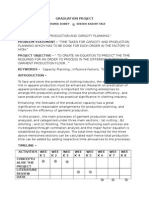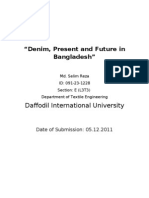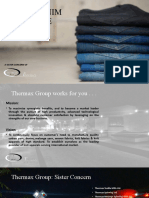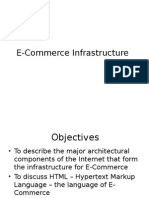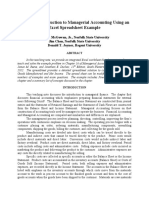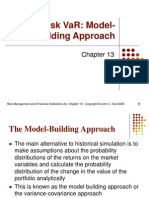Trim Defects
Trim Defects
Uploaded by
Vaswee DubeyCopyright:
Available Formats
Trim Defects
Trim Defects
Uploaded by
Vaswee DubeyOriginal Description:
Copyright
Available Formats
Share this document
Did you find this document useful?
Is this content inappropriate?
Copyright:
Available Formats
Trim Defects
Trim Defects
Uploaded by
Vaswee DubeyCopyright:
Available Formats
Trims
Trims must be compatible with base fabric and where appropriate match with
the shade of the base fabric
Trims must conform to standards specified by Buyer with respect to colour,
quantity, quality, safety and utility
All trims including draw strings, piping, buttons, zippers must be checked for
colour fastness and shrinkage prior to production
Trimmings should have the ability to be attached in a secure manner to the
body fabric
Trims must be safe with respect to toxicity, colorants, coatings etc
Trims must not cause irritation or hurt the customer after adorning the garment
Dyes used on trims must not be carcinogenic
Fusing/Interlinings
nterlinings must be compatible with base fabric weight and fibber composition
nterlinings must conform to standards specified by buyer
The colour must be compatible with the base fabric especially as the fusible
could show through or influence base fabric shade
!usible should be selected based on type of construction"woven, non#woven,
knitted$, the resin and the process to be used"pressure and temperature
applied$
!usible after fusing must withstand laundering, cleaning and abrasion
!usible which causes a strike back"penetration of adhesive to other surfaces in
the interlining$ and strike through"penetration of adhesive to the outer fabric
surface$ %will be re&ected
nterlinings must be positioned to provide support and shape where required
Linings
'olour fastness and performance of lining to be compatible with base fabric
(inings must conform to standards specified by buyer
)here wadded linings are used polyester wadding is required of specified
weight and density
Dye should not be carcinogenic
Accessories
All accessories"hangers, tags, card boards, poly bags, pins, clips$ must be,
colour fast, and conform to other standards prescribed by buyer
Accessories must not damage*distort the garment directly or indirectly
Accessories must be uniform within a lot
Elastic
+ust have the specified width , sufficient strength and elasticity for garment
comfort
,lastics must maintain the properties throughout the life of the garment with due
allowances for wash and care
t must be free of additives that can adversely affect the base fabric, lining or
trimmings and must be odour free
,lastic shrinkage must be specified
Bindings
+ust be appropriate and compatible for base fabric
+ust be colour fast, have the specified strength and width, and the proper finish
+ust not cause puckers or twisting after attaching
+ust not have &oints along the length
Labels
+ust be colour fast and have a sound construction
The words*logos*instructions*pictures must be clearly printed*embroidered on
the label
(abels instructions must be clearly understood by the supplier and only then
manufactured
(abels should have the right margin for attaching*insertion
(abels should have no loose fibres or uneven edges
)henever loop labels are used the label should be inserted appropriately with
the allowance on the label pushed fully into the seam and not showing outside
)henever labels have to be secured on four sides the stitch lines have to be
even and label shape undistorted
-aw edges must be concealed within seams and labels positioned at a
consistent distance from a referral point e.g. +ain label positioned centrally at /
cm below the neckband
Threads attaching the labels must be neatly trimmed
The embroidered*printed matter on the label must not be concealed
Drawstrings/Cords
'ords once knotted should not open up
,nd toggles should not open up, should be colour fast, lead and toxic free and
should not distort on laundering
Pocketing
0ocketing colour must be appropriate for body fabric, unless specified and must
conform to standards specified by buyer
0ocketing fabric must be able to withstand very high stress and also be colour
fast
Buttons
+ust be dyed to match unless specified
+ust be colour fast
+ust be compatible with body fabric when secured
+ust be non toxic
Buttons should not have sharp edges
+aterial should not chip off when sub&ected to laundering, ironing or other
forces
Buttons should not melt when sub&ected to high temperatures
Buttons should not be affected by solvents
The holes should be symmetrical with respect to its centre
+etal buttons should have rust proof finish
Buttons must retain its properties throughout the life of the garment
Buttons must be able to withstand scratches
The buttons are spaced correctly for their size and for the location of their use
The buttons are reinforced according to the dictates of the fabric and location
The buttons are sewn on securely
The buttonholes are the correct type for the garment design and fabric
The buttons and buttonholes are correctly aligned
The buttons should be securely attached with no fraying or loose threads
The buttonholes fit the buttons without gaping open or allowing the buttons to
come through too easily
Rivets !tuds
These must be rust proof, colour fast and have a good finish
The sizes must be as specified
'ompatible washers should be supplied along with the rivets and studs
f there is an embossing or print it should be able to withstand the die force
applied
!asteners are the correct size for the closure requirement
!asteners are attached securely, whether mechanically or by hand
'oncealed application of fasteners are inconspicuous
!asteners used in visible applications are suitable for the apparel design and
fabric
"i##ers
1ippers should conform to the specified length and width
1ippers should be rust proof
t should have a good quality stopper*slider and teeth
t should have auto lock mechanism
The zip slider must be free from obstruction when functioning and not catch
base fabric in its movement
t should be colour fast and not wear out on frequent use
t should be compatible with base fabric
t should posses the ability to allow stitch formation and securable to the base
fabric
The top of the zip should have a top stop where necessary as the slider can
come off
The zipper teeth should have even edges to allow free movement of the slider
The zipper teeth and tape materials are suitable for the apparel design and
fabric
The zipper length is adequate for ease in wearing or using the item
The method of attachment is appropriate to the garment design
All visible stitching is neatly done
The zipper is securely inserted into the garment "1ippers in trousers should
come upto the waistband, in dresses should come upto the fabric$
1ipper teeth are concealed adequately by lapped applications
(apped applications are evenly done
1ipper should be attached neatly with the correct stitch margin taken and
without puckering
During construction sufficient clearance should be given to allow smooth
operation and to minimize likelihood of slider catching base fabric or lining
2n open ended zips bar tacking or securing to base is required
T$reads
Thread selected must be appropriate for the fabric in size, composition, strength
and shrinkage characteristics.
+anufacturers should discuss thread selection with suppliers and equipment
technicians whenever necessary.
Thread colour must match the base fabric "unless otherwise specified$ and be
colour fast.
2verlocking thread should match the base fabric where practicable.
Bartack and other threads should match the base fabric where practicable.
Thread properties should be maintained during storage.
3ewing thread affects the strength of the finished garment, the quality of seams
sewn and the effectiveness with which equipment can be used4 hence correct
selection is essential.
Embroider%
,mbroidery threads must be consistent with the performance characteristics of
the base fabric
,mbroidery threads must match the base fabric and remain colour fast
Direct embroidery motifs must have the backing of soft tissue or interlining
removed"if present$ prior to delivery
,mbroidery must be correctly positioned and aligned. ,mbroidery threads must
be securely tied off and clipped. ,mbroidery must appear flat without pucker
or distortion.
Accessor% A##lication and Detailing
Pockets
Inseam #ockets
The lining should not extend past the hem or facing of the garment
2penings angular or on bias to be reinforced to prevent stretching. Twill or
seam tape to be used for this purpose
3eams should lie flat without pulling or puckering edges have been finished as
the fabric and location demand
(ining fabric, if used for the pocket bag, is durable, appropriate, and has the
same care requirements as the fabric "dyeing, shrinkage and fabric structure$
The body of the pocket has been anchored where possible to maintain position
and prevent sagging
The edges of the pocket opening are the same size, with no puckering or pulling
on either side
0ocket lining is recessed enough so as to not show during movement or while
sitting
!las$ed #ockets
2penings, flaps, and welts have been interfaced where necessary for body and
shape maintenance
!laps, when present, are the same length as the welts and lie flat
!ashion fabric if applied to the pocket lining should be directly beneath the
pocket opening when buttonholes or narrow single welts are used, to prevent
the lining from showing when the pocket is being used
!abric triangles formed at the ends of the slashed openings are secured with
bartacks or several small stitches to prevent holes from developing when the
pocket is being used
0aired pockets are identical in length and width and are equidistant from the
garment edge
0ockets lie flat without pulling, twisting or puckering
Applied pockets
0ockets were cut on grain and any fabric designs were matched. f a biased cut
was used, pockets were not stretched and have been properly stabilized with a
lining
The corners are free of any raw edges or any lining fabric visible
'urves, if present are smooth and sides are symmetrical
0aired pockets are the same height, size and shape
The location on the turning point of lined pockets is not visible from the right
side
(inings do not roll to the right side at the edges of the pocket, but remain out of
sight
f used, top stitching is an equal distance from the edges at all points
An appropriate stitch length has been used, and all loose thread ends have
been removed
0ockets and flaps lie flat without puckering, twisting sagging or rolling
!tandards &or evaluating waistline &acings
The facing is cut so that it5s grainline matches the garment grainlines
The facing lies flat and smooth against the garment
6o seam wells are evident at any point on the facing
The raw edges of the facing are finished appropriately
Belt loops or thread carriers, if present, are securely attached, evenly spaced,
and identical in size and construction
At any opening"s$ in the garment, the facing is neat, flat and concealed
You might also like
- Textile Industry Internship ReportDocument138 pagesTextile Industry Internship ReportArchana Rawat0% (1)
- Custom Molds Case StudyDocument13 pagesCustom Molds Case StudyAnkur Jain100% (3)
- H and M Quality Standards and RequiremenDocument16 pagesH and M Quality Standards and RequiremenAmisha SinghNo ratings yet
- Modern Cotton Spinning Machinery, Its Principles and ConstructionFrom EverandModern Cotton Spinning Machinery, Its Principles and ConstructionNo ratings yet
- Concept NoteDocument13 pagesConcept NoteVaswee Dubey100% (1)
- Terms Conditions BL LARA CMA CGM A4 ValideDocument1 pageTerms Conditions BL LARA CMA CGM A4 ValideDanish Azmi100% (1)
- 10 Steps To Calculating The Lower Limit of Individually Significant ItemsDocument1 page10 Steps To Calculating The Lower Limit of Individually Significant ItemsAnonymous Ul3litqNo ratings yet
- Marginal Cost Analysis of Britannia: Presented By: Shraddha Bhatt (A024) Jincey Jose (A009) Richa Tupsakhare (A022)Document29 pagesMarginal Cost Analysis of Britannia: Presented By: Shraddha Bhatt (A024) Jincey Jose (A009) Richa Tupsakhare (A022)Sriram MNo ratings yet
- Binary Ebook (Secure)Document17 pagesBinary Ebook (Secure)sagbes100% (3)
- Deposit Campaign in BanksDocument15 pagesDeposit Campaign in BanksAnkurKumarNo ratings yet
- ChapterDocument47 pagesChapterThe Style ProjectNo ratings yet
- Arvind PDFDocument27 pagesArvind PDFDivyata Nanda100% (1)
- Textile Design Internship DocumentDocument96 pagesTextile Design Internship DocumentswathiNo ratings yet
- SocksanditsmanufacturingDocument9 pagesSocksanditsmanufacturingMian ShoaibNo ratings yet
- Dnls MMDocument19 pagesDnls MMpriyal100% (1)
- Understanding Apparel QualityDocument10 pagesUnderstanding Apparel QualityKumar GauravNo ratings yet
- Technical YarnsDocument10 pagesTechnical YarnsNivedini uNo ratings yet
- Textile Internship Alok IndustriesDocument31 pagesTextile Internship Alok IndustriesAditya DevNo ratings yet
- Power Looms Summer Training ProjectDocument100 pagesPower Looms Summer Training ProjectSagar Virani100% (1)
- Textile Internship Report: Ocm Private Limited Textile Unit, AmritsarDocument49 pagesTextile Internship Report: Ocm Private Limited Textile Unit, AmritsarJyoti Rawal100% (1)
- Module 9 - Garment Industy Plant LayoutDocument4 pagesModule 9 - Garment Industy Plant LayoutNECIE JOY LUNARIONo ratings yet
- Spme Jury AssignmentDocument52 pagesSpme Jury AssignmentPalak AggarwalNo ratings yet
- Advanced Apparel Manufacturing ManagementDocument27 pagesAdvanced Apparel Manufacturing ManagementPrachi YashNo ratings yet
- Internship ReportDocument20 pagesInternship Reportveenaos0% (1)
- Denim Present and Future of Bangladesh (For Selim)Document12 pagesDenim Present and Future of Bangladesh (For Selim)shohagh12133% (3)
- Payal INTICEDE (MFM.22.54)Document103 pagesPayal INTICEDE (MFM.22.54)Payal ParidaNo ratings yet
- Knit Asia Operation ProcessDocument12 pagesKnit Asia Operation ProcessParvezMridhaNo ratings yet
- Stree MGMT of T.C Terrytex Ltd.Document55 pagesStree MGMT of T.C Terrytex Ltd.Mahfooz IlahiNo ratings yet
- Apparel Internship CollgDocument135 pagesApparel Internship CollgHanish Singla100% (1)
- Sewbot Clothingmanufacturing 190202115439 PDFDocument41 pagesSewbot Clothingmanufacturing 190202115439 PDFpriyalNo ratings yet
- Ishita PatnaikDocument60 pagesIshita PatnaiklolNo ratings yet
- Case Study: Arvind Mills LTD.: Prepared By: Kavita Chokshi (04) Digesh Shah (22) Pritesh Shah (25) Chirag SutharDocument83 pagesCase Study: Arvind Mills LTD.: Prepared By: Kavita Chokshi (04) Digesh Shah (22) Pritesh Shah (25) Chirag SutharDigesh Shah100% (3)
- Aaryan Jain SUMMER INTERNSHIP REPORTDocument39 pagesAaryan Jain SUMMER INTERNSHIP REPORTMonty SharmaNo ratings yet
- Page1 8Document21 pagesPage1 8Yuvraj PahujaNo ratings yet
- INTRODUCTION & Overview of PR CHEMICAL PROCESSINGDocument74 pagesINTRODUCTION & Overview of PR CHEMICAL PROCESSINGOliyad EbbaNo ratings yet
- AP - Jury Assignment - TechpackDocument11 pagesAP - Jury Assignment - TechpackDivyanshi GoelNo ratings yet
- Nift CRD Report FinalDocument168 pagesNift CRD Report FinalRicha Upadhyay100% (1)
- Sister Denim Composite Limited: Karardi, Shibpur, NarsingdiDocument18 pagesSister Denim Composite Limited: Karardi, Shibpur, NarsingdiIsrafil AlamNo ratings yet
- Arvind IntershipDocument52 pagesArvind IntershipAnurag MosanNo ratings yet
- Utm JSML FinalDocument48 pagesUtm JSML FinalVaisistha BalNo ratings yet
- Denim Jeans Stitching Unit (Rs. 19.04, Dec-2015)Document21 pagesDenim Jeans Stitching Unit (Rs. 19.04, Dec-2015)Hammad TauqeerNo ratings yet
- Seam ClassificationDocument36 pagesSeam ClassificationVishal ChoudharyNo ratings yet
- Kesarinandan Knit FabsDocument42 pagesKesarinandan Knit Fabsmk_bothraNo ratings yet
- Industry Visit Report of Sai Baba Garments: BY - Ashish Bhuwania BFT/17/381Document8 pagesIndustry Visit Report of Sai Baba Garments: BY - Ashish Bhuwania BFT/17/381ravikantNo ratings yet
- Apparel InternshipDocument104 pagesApparel InternshipPraveen PrabhakarNo ratings yet
- Raymond Visit ReportDocument12 pagesRaymond Visit ReportMandy Terrell100% (1)
- Natific AG Instructional User Guide ColorWarehouse (En)Document76 pagesNatific AG Instructional User Guide ColorWarehouse (En)Ahmed Firoz100% (1)
- Viva Questions and Answers For Garments and Merchandising Job (Part-1) - Textile Learner PDFDocument1 pageViva Questions and Answers For Garments and Merchandising Job (Part-1) - Textile Learner PDFMABVUTO TEMBONo ratings yet
- Textile Internship Guidelines (BFT-V) 20.01.2020 PDFDocument9 pagesTextile Internship Guidelines (BFT-V) 20.01.2020 PDFSejal Goyal100% (1)
- UAQ 2nd Assignment (Pooja Kumari)Document14 pagesUAQ 2nd Assignment (Pooja Kumari)Reena VermaNo ratings yet
- Apparel Industry Plant LayoutDocument9 pagesApparel Industry Plant LayoutHemant KumarNo ratings yet
- Jute ProcessingDocument7 pagesJute Processingtulika_ajwaniNo ratings yet
- 6.2 Assign 1-SNLS MachineDocument25 pages6.2 Assign 1-SNLS MachineAreef Khan100% (1)
- Weaving Process Interlaces The WarpDocument8 pagesWeaving Process Interlaces The WarpChetna SinghNo ratings yet
- An Overview of Raymond Limited With Emphasis OnDocument67 pagesAn Overview of Raymond Limited With Emphasis OnShailja JajodiaNo ratings yet
- 1.1 Problem Statement:: 1.2 Scope of The StudyDocument19 pages1.1 Problem Statement:: 1.2 Scope of The StudyKAWSER RAFINo ratings yet
- Pin Table.Document21 pagesPin Table.Silky Prajapati100% (1)
- Silk Weaving - KanchipuramDocument31 pagesSilk Weaving - KanchipuramananyaNo ratings yet
- DNLSDocument4 pagesDNLSshrutiagarwal9229No ratings yet
- De - Skilling DevicesDocument42 pagesDe - Skilling DevicesAnand DubeyNo ratings yet
- University Of: South AsiaDocument51 pagesUniversity Of: South Asiamehedi hasanNo ratings yet
- Guidelines For The Textile Internship-FinalDocument6 pagesGuidelines For The Textile Internship-FinalPiyush PatelNo ratings yet
- Proj ReportDocument40 pagesProj Reportshriya_bupathNo ratings yet
- Disha Kapil (11) Stanley SayoniDocument12 pagesDisha Kapil (11) Stanley Sayonisahu_dishaNo ratings yet
- Carr and Latham's Technology of Clothing ManufactureFrom EverandCarr and Latham's Technology of Clothing ManufactureDavid J. TylerRating: 4 out of 5 stars4/5 (1)
- Sewing Success?: Employment, Wages, and Poverty following the End of the Multi-Fibre ArrangementFrom EverandSewing Success?: Employment, Wages, and Poverty following the End of the Multi-Fibre ArrangementNo ratings yet
- Format - Placement Status - 2015 - Deptt.Document47 pagesFormat - Placement Status - 2015 - Deptt.Vaswee DubeyNo ratings yet
- 1-Sessionwhat Is MerchandisingDocument8 pages1-Sessionwhat Is MerchandisingVaswee DubeyNo ratings yet
- E-Commerce InfrastructureDocument36 pagesE-Commerce InfrastructureVaswee DubeyNo ratings yet
- Quality Function DeploymentDocument40 pagesQuality Function DeploymentVaswee Dubey100% (1)
- Fusing Machines: BY-Sheikh Kashif Faiz Mamshi Oshin Vaswee DubeyDocument36 pagesFusing Machines: BY-Sheikh Kashif Faiz Mamshi Oshin Vaswee DubeyVaswee Dubey100% (1)
- Colgate PalmoliveDocument2 pagesColgate PalmoliveVaswee Dubey100% (1)
- SkirtDocument5 pagesSkirtsivathmiga100% (1)
- Lesson 3 Completing The Accounting CycleDocument6 pagesLesson 3 Completing The Accounting CycleklipordNo ratings yet
- Kinowear Program - Full Access To The Basics' Module - KinowearDocument14 pagesKinowear Program - Full Access To The Basics' Module - KinowearXue Adams0% (1)
- Business PlanDocument31 pagesBusiness PlanBabasab Patil (Karrisatte)100% (1)
- National Budget Memorandum No. 129 Reaction PaperDocument2 pagesNational Budget Memorandum No. 129 Reaction PaperVhia ParajasNo ratings yet
- Cs Coca Cola EngDocument4 pagesCs Coca Cola EngLekha DeshmukhNo ratings yet
- Chapter 6: The Risk and Term Structure of Interest RatesDocument22 pagesChapter 6: The Risk and Term Structure of Interest RatesThi MinhNo ratings yet
- Ch10 Thomson Answers To QuestionsDocument6 pagesCh10 Thomson Answers To Questionsgeorgeterekhov100% (1)
- Portfolio ManagementDocument35 pagesPortfolio Managementhemant verma100% (1)
- 22222222222222' LSDJVKLKDDocument11 pages22222222222222' LSDJVKLKDRaman GuptaNo ratings yet
- China Automobile Parts Accessories Industry Profile Cic3725Document8 pagesChina Automobile Parts Accessories Industry Profile Cic3725AllChinaReports.comNo ratings yet
- Teaching Introduction To Managerial Accounting Using An Excel Spreadsheet ExampleDocument16 pagesTeaching Introduction To Managerial Accounting Using An Excel Spreadsheet Examplesamuel kebedeNo ratings yet
- Chapter 10 Notes Place and Development of Channel SystemsDocument5 pagesChapter 10 Notes Place and Development of Channel SystemsDa KaizokuōNo ratings yet
- Integration SheetDocument68 pagesIntegration SheetMayank Shahabadee100% (1)
- Mary Ann RodriguezDocument15 pagesMary Ann RodriguezIngrid NavarroNo ratings yet
- Strategic ManagementDocument34 pagesStrategic ManagementDewi PuspitaNo ratings yet
- Persentase ManriskDocument23 pagesPersentase ManriskJaka ThebassNo ratings yet
- Product Life CycleDocument8 pagesProduct Life CycleranokshivaNo ratings yet
- HZL - Price Circular 07.01.2016Document3 pagesHZL - Price Circular 07.01.2016Imtiaz BhadiNo ratings yet
- Chapter 6 - Using Discounted Cash Flow Analysis To Make Investment DecisionsDocument14 pagesChapter 6 - Using Discounted Cash Flow Analysis To Make Investment DecisionsSheena Rhei Del RosarioNo ratings yet
- Infrastructure Notes - IAS MAINS PDFDocument5 pagesInfrastructure Notes - IAS MAINS PDFvipul04570% (1)
- KENZODocument8 pagesKENZOAlejandra CaycedoNo ratings yet
- Regional Portfolio Facilities Property Manager in Los Angeles CA Resume Bob KosbergDocument1 pageRegional Portfolio Facilities Property Manager in Los Angeles CA Resume Bob KosbergBobKosbergNo ratings yet
- User Training Manual - PS - TP - End User V1.2Document108 pagesUser Training Manual - PS - TP - End User V1.2Rahul KumarNo ratings yet




